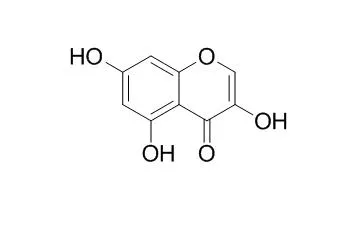| Animal Research: |
| Chinese Traditional & Herbal Drugs, 2014, 45(7):900-905. | | Chemical constituents from Ampelopsis cantoniensis and their anti-angiogenic activities.[Reference: WebLink] |
To study the chemical constituents from Ampelopsis cantoniensis and their antiangiogenesis activities.
METHODS AND RESULTS:
The compounds were isolated and purified by various chromatographic techniques and their structures were elucidated by spectral analysis, the antiangiogenic activities of compounds isolated were evaluated using a zebrafish model. Fifteen compounds were obtained and identified as cantonienol (1), nootkatone (2), aromadendrane-4β,10β-diol (3), abscisic acid (4), 12-oxo-hardwickiic acid (5), betulinic acid (6), platanic acid (7), vanillic acid (8), resveratrol (9), nectandrin B (10), nectandrin A (11), 3,5,7-Trihydroxychromone (12), 5,7,3',4',5'-pentahydroxyflavanone (13), taxifolin (14) and myricitrin (15).
CONCLUSIONS:
Compound 1 is a new sesquiterpene and named as cantonienol. Compounds 2–7 and 10–12 are isolated from the Ampelopsis plants for the first time, and the other compounds are firstly reported in this plant. Compounds 9, 11 and 12 exhibited weak antiangiogenic activity when evaluated using a zebrafish model. |
|
| Structure Identification: |
| Zhongguo Zhong Yao Za Zhi. 2009 Jul;34(13):1690-1. | | Chemical constituents in herbs of Polygonum jucundum.[Pubmed: 19873783] | To investigate the chemical constituents in herbs of Polygonum jucundum.
METHODS AND RESULTS:
The 85% ethanol extract was separated by means of silica gel and Sephadex LH-20 column chromatography. The compounds isolated from the plant were identified by physicochemical properties and spectroscopic evidence. Eight compounds were isolated and identified as: quercetin-3'-O-beta-D-galactoside (1), 8-methoxyquercetin (2), pigenin (3), luteolin (4), quercetin (5), 3,5,7-Trihydroxychromone (6), p-hydroxybenzaldehyde (7), beta-sitosterol (8).
CONCLUSIONS:
All compounds were isolated from this plant for the first time, compounds 5- 8 were isolated from the genus Polygonum for the first time. |
|






 Cell. 2018 Jan 11;172(1-2):249-261.e12. doi: 10.1016/j.cell.2017.12.019.IF=36.216(2019)
Cell. 2018 Jan 11;172(1-2):249-261.e12. doi: 10.1016/j.cell.2017.12.019.IF=36.216(2019) Cell Metab. 2020 Mar 3;31(3):534-548.e5. doi: 10.1016/j.cmet.2020.01.002.IF=22.415(2019)
Cell Metab. 2020 Mar 3;31(3):534-548.e5. doi: 10.1016/j.cmet.2020.01.002.IF=22.415(2019) Mol Cell. 2017 Nov 16;68(4):673-685.e6. doi: 10.1016/j.molcel.2017.10.022.IF=14.548(2019)
Mol Cell. 2017 Nov 16;68(4):673-685.e6. doi: 10.1016/j.molcel.2017.10.022.IF=14.548(2019)